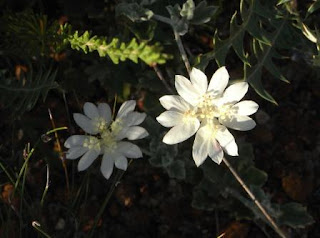He tested the battery and that was fine, and couldn't work out the problem. Then he said it was with 'more arse than class' that he noticed a tiny wire was broken....when these were touched together, the car started....cause? A rat had chewed through one wire and made a start on another. (There were rat droppings on the engine). After a trip into town to purchase a soldering iron (he hadn't brought the car with the full equipment) he fixed it all up and the car started!
Then the problem was me... I felt we would be pushing our luck going on.... out of range for days and further from home and felt too stressed...so we finished up going to Kalgoorlie, heading home.
On the way we stopped for a walk, and saw a lovely dragon that was at least 30cm long....he just froze on the path and we could get close to him.
also a big red spider.
We have had a wonderful time - not so good for the birds, but so many beautiful flowers and stunning scenery.





















































